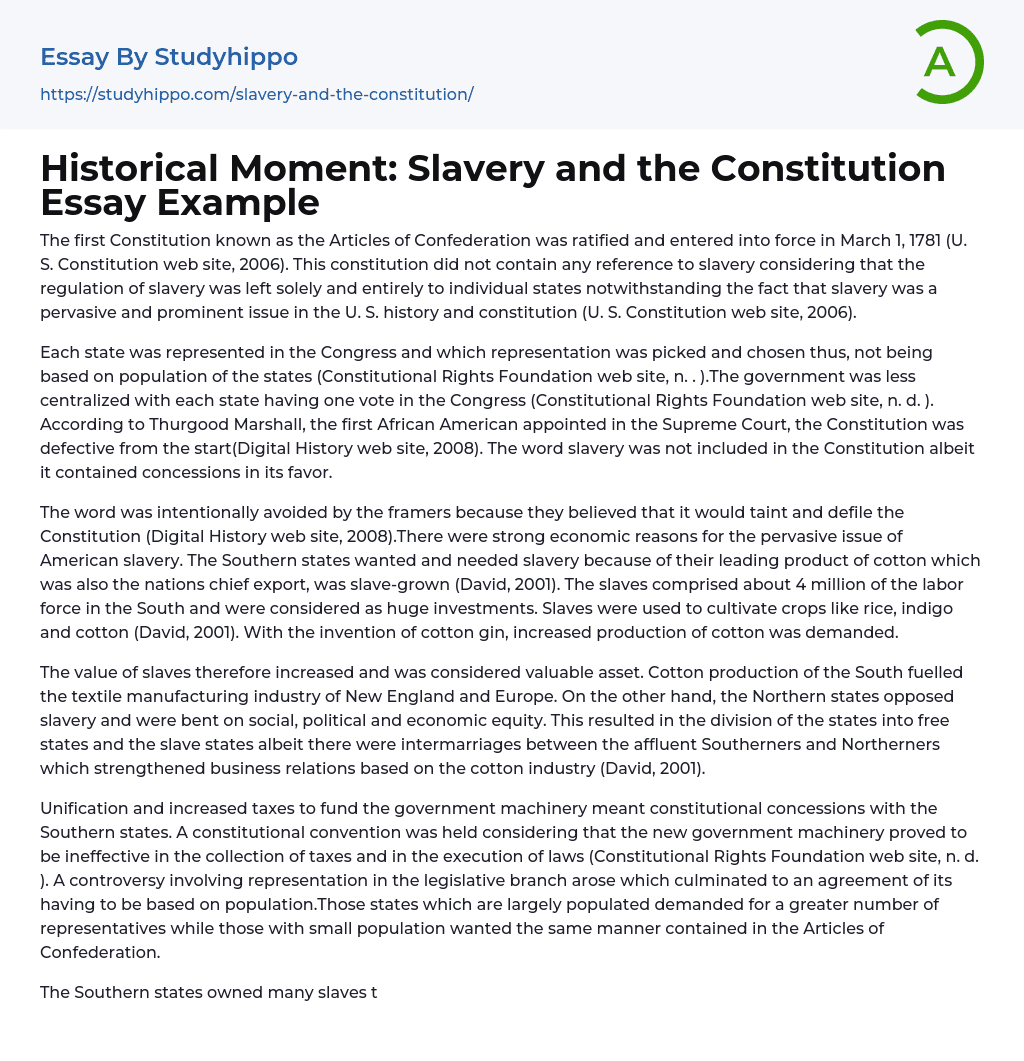The first Constitution known as the Articles of Confederation was ratified and entered into force in March 1, 1781 (U. S. Constitution web site, 2006). This constitution did not contain any reference to slavery considering that the regulation of slavery was left solely and entirely to individual states notwithstanding the fact that slavery was a pervasive and prominent issue in the U. S. history and constitution (U. S. Constitution web site, 2006).
Each state was represented in the Congress and which representation was picked and chosen thus, not being based on population of the states (Constitutional Rights Foundation web site, n. . ).The government was less centralized with each state having one vote in the Congress (Constitutional Rights Foundation web site, n. d. ). According to Thurgood Marshall, the first African American appointed in the Supreme Court, the Constitution was
...defective from the start(Digital History web site, 2008). The word slavery was not included in the Constitution albeit it contained concessions in its favor.
The word was intentionally avoided by the framers because they believed that it would taint and defile the Constitution (Digital History web site, 2008).There were strong economic reasons for the pervasive issue of American slavery. The Southern states wanted and needed slavery because of their leading product of cotton which was also the nations chief export, was slave-grown (David, 2001). The slaves comprised about 4 million of the labor force in the South and were considered as huge investments. Slaves were used to cultivate crops like rice, indigo and cotton (David, 2001). With the invention of cotton gin, increased production of cotton was demanded.
The value of slaves therefore increased and was considered valuable
asset. Cotton production of the South fuelled the textile manufacturing industry of New England and Europe. On the other hand, the Northern states opposed slavery and were bent on social, political and economic equity. This resulted in the division of the states into free states and the slave states albeit there were intermarriages between the affluent Southerners and Northerners which strengthened business relations based on the cotton industry (David, 2001).
Unification and increased taxes to fund the government machinery meant constitutional concessions with the Southern states. A constitutional convention was held considering that the new government machinery proved to be ineffective in the collection of taxes and in the execution of laws (Constitutional Rights Foundation web site, n. d. ). A controversy involving representation in the legislative branch arose which culminated to an agreement of its having to be based on population.Those states which are largely populated demanded for a greater number of representatives while those with small population wanted the same manner contained in the Articles of Confederation.
The Southern states owned many slaves therefore by including them in the head count of the population would mean increasing the number of representation they would have in the legislature (Constitutional Rights Foundation web site, n. d. ). By increasing representation, these states necessarily would increase their power but consequently, they would be paying more taxes.This consequence was something the Southern states were later on amenable to bear.
Thus, finally the states agreed to have the representation in the House of Representatives as one based on population and the representation in the Senate as having two members per state (Constitutional Rights Foundation web site, n.d. ). This was later
known to be the Great Compromise or the Three-Fifths Compromise wherein the slaves were included as part of the population with an equivalency three fifths of slave population in apportioning representation (Digital History web site, 2008).This in effect, gave the South states extra votes and representation in the legislature. The slaves were referred to as persons.
Anent other constitutional concessions on slavery other than the Three-Fifths Compromise, a fugitive save clause was included as a result of the approval of Congress of the Northwest Ordinance which ensured the escapee slaves from being returned to their owners (Constitutional Rights Foundation web site, n. d. ).In exchange for the support of the New England states for this clause, they received trade concessions. This fugitive save clause is found in Article IV, Section 2 of the 1787 Constitution (Russell, 2007). Another instance of constitutional reference to slavery is the proscription of prohibiting slavery until the year 1800. A compromise was reached that the Congress can only be allowed the authority to ban slavery in 1808 which was extended by votes up to 1808 (Constitutional Rights Foundation web site, n. d.).
- First Amendment essays
- Jurisprudence essays
- Social Injustice essays
- Juvenile Justice essays
- Slave Trade essays
- Agreement essays
- Business Law essays
- Common Law essays
- Community Policing essays
- Constitution essays
- Consumer Protection essays
- Contract essays
- Contract Law essays
- Copyright Infringement essays
- Court essays
- Crime essays
- Criminal Law essays
- Employment Law essays
- Family Law essays
- Injustice essays
- Judge essays
- Jury essays
- Justice essays
- Lawsuit essays
- Lawyer essays
- Marijuana Legalization essays
- Ownership essays
- Police essays
- Property essays
- Protection essays
- Security essays
- Tort Law essays
- Treaty essays
- United States Constitution essays
- War on Drugs essays
- Armed Forces essays
- Confederate States Of America essays
- Federal government essays
- Federal Government Of The United States essays
- Fourteenth Amendment To The United States Constitution essays
- Governance essays
- Jurisdiction essays
- Parliament essays
- Politics essays
- Abolitionism essays
- Adam Smith essays
- American History essays
- American Revolution essays
- Ancient Egypt essays
- Articles Of Confederation essays




